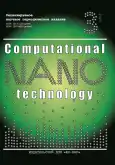Assessment of the possibilities of using behavioral biometrics: analysis of computer mouse movements to protect remote administration sessions
- Authors: Uymin A.G.1, Belousov A.V.1
-
Affiliations:
- National University of Oil and Gas “Gubkin University”
- Issue: Vol 12, No 3 (2025)
- Pages: 170-177
- Section: INFORMATICS AND INFORMATION PROCESSING
- URL: https://bakhtiniada.ru/2313-223X/article/view/350197
- DOI: https://doi.org/10.33693/2313-223X-2025-12-3-170-177
- EDN: https://elibrary.ru/BULODR
- ID: 350197
Cite item
Abstract
The purpose of this work is to substantiate the possibilities of using mouse dynamics as a method of behavioral biometrics for the tasks of continuous authentication of system administrators in remote access conditions. The research focuses on studying the features of mixed (discrete-continuous) data transmission channels and the specifics of using GUI interfaces used in modern administration scenarios. The paper considers formal models for processing behavioral signs, suggests an approach to integrating asynchronous and fragmentary signals, and performs a comparative analysis of biometric methods based on stability criteria, the possibilities of application in background modes, and the possibility of integration without additional equipment. Particular attention is paid to the architectural requirements for Continuous Authentication Systems (CAS), including assessing the adaptability of models and determining their resistance to data flow fragmentation. The analysis results confirm that mouse dynamics has balanced characteristics for passive biometric authentication.: It is actively used in software and hardware platforms with a graphical interface, does not require specialized sensors, and provides good identification quality with a low level of interference. It is shown that this type of biometric authentication can be effectively applied in conditions of an unstable channel, while meeting the requirements for synchronization, aggregation and profile adaptation. The proposed recommendations on the architecture of CAS systems are focused on real-world application in the IT infrastructure without compromising performance and user experience.
Full Text
##article.viewOnOriginalSite##About the authors
Anton G. Uymin
National University of Oil and Gas “Gubkin University”
Author for correspondence.
Email: au-mail@ya.ru
ORCID iD: 0000-0003-1572-5488
SPIN-code: 1156-4517
Scopus Author ID: 58568130300
senior lecturer
Russian Federation, MoscowAlexander V. Belousov
National University of Oil and Gas “Gubkin University”
Email: belousov.a@gubkin.ru
ORCID iD: 0000-0002-5719-4251
SPIN-code: 8603-7439
ResearcherId: J-2484-2014
Cand. Sci. (Eng.), Associate Professor, Head, Department of Information Technology Security
Russian Federation, MoscowReferences
- Almohri H.M.J., Yao D., Kafura D. Process authentication for high system assurance. IEEE Transactions on Dependable and Secure Computing. 2013. Vol. 11. No. 2. Pp. 168–180.
- Alrawili R., AlQahtani A.A.S., Khan M.K. Comprehensive survey: Biometric user authentication application, evaluation, and discussion. Computers and Electrical Engineering. 2024. Vol. 119. 109485.
- Ayeswarya S., Singh K.J. A comprehensive review on secure biometric-based continuous authentication and user profiling. IEEE Access. 2024.
- Dave R. et al. From clicks to security: Investigating continuous authentication via mouse dynamics. arXiv preprint arXiv:2403.03828. 2024.
- Jenkins A.D.G. et al. Not as easy as just update: Survey of system administrators and patching behaviours. In: Proceedings of the 2024 CHI Conference on Human Factors in Computing Systems. 2024. С. 1–17.
- Kanak A., Sogukpinar I. BioPSTM: a formal model for privacy, security, and trust in template-protecting biometric authentication. Security and Communication Networks. 2014. Vol. 7. No. 1. Pp. 123–138.
- Khan S. et al. Mouse dynamics behavioral biometrics: A survey. ACM Computing Surveys. 2024. Vol. 56. No. 6. Pp. 1–33.
- Ojo S. et al. Identity and Access Management (IAM) authentication methods: Importance of Multi-Factor Authentication (MFA) and Single Sign-On (SSO) and access control models. 2025.
- Orun A., Orun E., Kurugollu F. Cognitive behavioural characteristics identification for remote user authentication for cybersecurity. Journal of Parallel and Distributed Computing. 2025. 105102.
- Smith-Creasey M. Continuous biometric authentication systems: An overview. Springer International Publishing. 2024. Pp. 1–118. (Springer Briefs in Computer Science)
- Szilágyi L. et al. Elevating security: Mouse dynamics in behavior biometrics for user identity authentication. In: IEEE 6th International Symposium on Logistics and Industrial Informatics (LINDI). IEEE, 2024. Pp. 000227–000232.
- Uymin A. Application of machine learning in the classification of traffic in telecommunication networks: working with network modeling systems. In: E3S Web of Conferences. International Scientific Siberian Transport Forum – TransSiberia 2023 (Novosibirsk, May 16–19, 2023). Vol. 402. Novosibirsk: Sciences, 2023. P. 03001. doi: 10.1051/e3sconf/202340203001. EDN: ZMBVYO.
- Wang C. et al. Behavioral authentication for security and safety. Security and Safety. 2024. Vol. 3. 2024003.
Supplementary files








